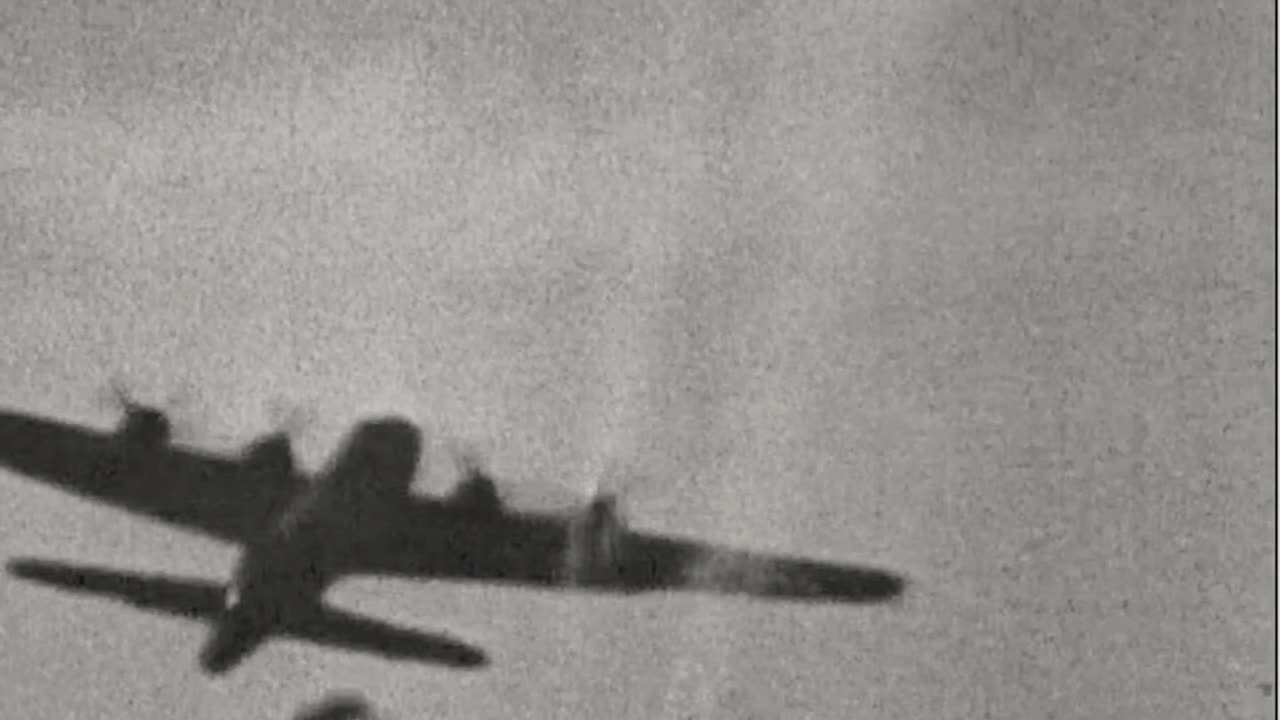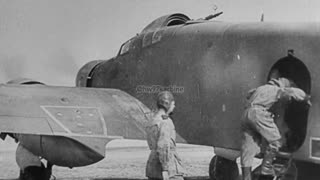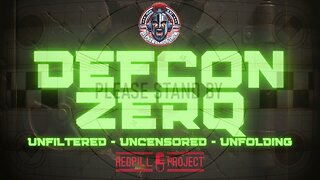Premium Only Content

Jagdgeschwader 54 Bf 109 G-6/R6 fighters intercepting USAAF B-17 Flying Fortress bombers in 1943
The Messerschmitt Bf 109 variants visible appear to be G-6 variants that replaced the pair of 7.92mm MG 17 machine guns in the engine cowling with a pair of 13mm MG 131 machine guns.
0:13 Ammunition belts for the MG 151/20 cannon are prepared, most of them appear to be yellow high explosive rounds with a relatively low number of black armor piercing rounds. Apart from the MG 131 machine guns, standard armament was a MG 151/20 cannon firing through the propeller hub. Most aircraft featured in the footage are also equipped with the Rüstsatz 6 kit that added two more cannon in underwing gondolas.
The added weight and drag of this installation hurt performance, however the increase in firepower made the aircraft more effective in the bomber destroyer role. Armor piercing shells were effective against vital elements of the bombers like the engines and crew, however these represented relatively small targets relative to the aircraft structure and hits were less likely. It was therefore deemed more effective to pack as much explosive as possible in shells to attack the aircraft structure itself, tearing open fuel tanks and damaging flying surfaces.
0:38 As the Bf 109's inertia starter is cranked, the "Beule" blisters over the MG 131 breeches are evident. Later 109 models replaced these blisters with more streamlined bulges along the length of the cowling.
1:12 Debris coming off the bomber bears witness to the effect of high explosive shells, and this was frequently a danger to the attacking aircraft as well. It was not unknown for fighters to be brought down after striking parts shot off their quarry.
1:27 This segment of Luftwaffe gun camera footage is unique in that it is possibly the only surviving clip where the aircraft under attack is identifiable by its squadron codes. In the last frames the code N-TU is visible suggesting this was 351st Bomb Group 510th Bomb Squadron Boeing B-17F Flying Fortress 42-30867.
The 351st Bomb Group's mission narrative indicates that this was the aircraft's second combat mission having been delivered to the 510th two weeks earlier, and it was one of five of the group's aircraft to be lost that day:
Mission No. 47 – October 9, 1943 The Group was briefed to attack the Arado Aircraft Factory at Anklam, Germany. The crews were very concerned when confronted by the mission details. It was the longest flight to date, with expected moderate to heavy flak concentrations. After the briefing, Sgt. Pete Zibas, the engineer on Lt. Garcia’s aircraft, recalls the gunners clamoring for an additional four cans of ammunition per gun. Twenty-one planes were led by Colonel Burns, Captain Carraway, and Lt. Norris with Lt. Stackhouse navigating and Lt. Winter as bombardier. The formation crossed the North Sea at 4,000 feet and prior to climbing to bombing altitude, the fuel was cross-fed into the main tanks and the bomb bay tanks jettisoned. As this operation was being carried out in Flight Officer Warring’s ship, 42-3152, fire broke out, but the crew managed to extinguish the flames and the ship continued in formation. Shortly after crossing the Danish coast, the first fighter attacks commenced. Thirty to fifty ME 109s pressed home many close attacks. The first plane to be hit was the second element lead, 42-30790, flown by Captain Morse. A burst of 20mm exploded in the left wing setting it on fire. Captain Morse dropped his wheels and left the formation under control. All the crew bailed out safely. At the start of the bomb run the enemy fighters broke off their attacks, leaving the formation to suffer the attentions of the Anklam flak gunners. Smoke from the bombs of the preceding combat wing obscured the target and as a consequence most of the bombs fell in the center of the city. Flight Officer Warring was still experiencing mechanical difficulties. He was force to jettison his bombs after the target when the bomb bay doors had to be hand-cranked open. The formation turned for home and flew straight into the Luftwaffe’s assembled forces. ME 110s and a few JU 88s stood off and fired rockets into the formation. Lt. Maser’s aircraft, 42-29603, left the formation with its ailerons shot out and number three engine on fire. All ten crewmen bailed out from the stricken aircraft, but only nine survived. What happened to Sgt. Gorsuch, the ball turret gunner, is not known. Sgt. Gorsuch was on his 25th mission, having substituted for the regular crew member, Sgt. Nadeau, who had been wounded on a previous mission. At the same time Lt. Christman, in 42-30867, and the luckless Flight Officer Warring went down. Despite injuries to several of Flight Officer Warring’s crew, they all managed to bail out. Eight members of Lt. Christman’s crew survived. Sgt. Blais and Butterbach were killed in the fighter attack. The fighter attacks persisted for some three and a half-hours after leaving the target. In the final stages, ME 109s and FW 190s from coastal fields joined in the attacks. It is believed that it was these fighters that shot down 42-29868, flown by Lt. Turley. Only Lt. Williams, the copilot, and Sgt. Curtis, the top turret gunner, survived the crash into the North Sea. They were picked up by the Germans near the Danish coast. When the Group landed at Polebrook it was found that Lt. Nardi’s ship, 42-29877, had returned with an unexploded rocket wedged in the main spar.
Of the crew on board 42-30867, Radio Operator David Pressel, Ball Turret Gunner John Butterbach and Tail Gunner Edmond Blais were killed in action.
The rest of the crew consisting of Pilot Lloyd Christman, Copilot: James Laird, Navigator Eldred Hancy, Bombardier John Hemm, Flight Engineer Commodore Sharp and Waist Gunners James White and William Klink baled out successfully and were taken prisoner.
Of the 16 aircraft from the group assigned to the mission that made it back to base, all suffered some form of battle damage, a lot of it from detonations of Werfer-Granate 21 rockets that were used by Luftwaffe fighters to break up the "combat box" defensive formations. Six men on board the returning aircraft were wounded in action, one of them seriously. With almost a quarter of the unit shot down, this is typical of the unsustainable loss rate suffered by the Eighth Air Force while flying without fighter escort during the time the Luftwaffe was still a force to be reckoned with.
I was unable to determine the identity of the Luftwaffe pilot awarded this particular victory however from the footage itself it appears that the attacking aircraft is a twin-engined fighter, likely a Messerschmitt Bf 110. There were several Zerstörergeschwader and even Nachtjagdgeschwader operating the type that claimed B-17 bombers on this day and the Missing Air Crew Report for 42-30867 does not give a precise location of the loss.
If you would like to support the channel consider visiting https://www.buymeacoffee.com/hw97karbine
-
 1:00
1:00
hw97karbine
14 days agoItalian Savoia Marchetti SM.79 bombers attack British shipping in the Mediterranean in 1940
46 -
 LIVE
LIVE
FreshandFit
10 hours agoShe Was Given Extravagant Gifts And STILL Friendzoned Him
15,478 watching -
 DVR
DVR
Man in America
8 hours agoOperation Gladio: The CIA, Mossad & City of London’s Plan for a New World Order
13.5K7 -
 2:11:41
2:11:41
Badlands Media
9 hours agoDEFCON ZERQ Ep. 016
56.7K33 -
 2:09:24
2:09:24
Inverted World Live
4 hours agoRats Have Learned to Hunt Bats | Ep. 135
21.3K4 -
 2:48:01
2:48:01
TimcastIRL
5 hours agoLIVE Election Coverage: Polling Stations SWATTED, Bomb Threats Called In | Timcast IRL
216K159 -
 3:30:07
3:30:07
Barry Cunningham
5 hours agoBREAKING NEWS: COUNTDOWN TO COMMUNISM! ELECTION RESULTS SHOW!
39.4K32 -
 2:11:28
2:11:28
DeVory Darkins
4 hours agoLIVE NOW: 2025 Election results and Exit Polls AMA
48.5K40 -
 LIVE
LIVE
DLDAfterDark
3 hours ago $0.03 earnedJust Another Tuesday - In Virginia - The Governor's Race & Glock Talk
108 watching -
 3:21:38
3:21:38
The Charlie Kirk Show
6 hours agoJUDGMENT DAY 2025: The Election Results Stream
175K75